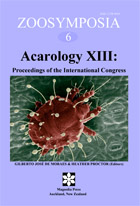Abstract
Coconut (Cocos nucifera L.) is an important crop in West Bengal, India. The coconut mite, Aceria guerreronis Keifer (Eriophyidae), is becoming a serious threat to its cultivation in that state. This mite lives underneath the perianth, attacking the epidermis and causing damage that leads to considerable yield reduction. The same habitat was found to be shared by several other mites during a one year study in a coconut orchard in South 24 Parganas District ofWest Bengal, in 2007–2008. In total, 11 species of nine families were found in this study, including mites of different feeding habits, but mainly predatory and phytophagous mites. Neoseiulus paspalivorus (De Leon) was the predominant predator, while A. guerreronis was the predominant phytophagous species. Both were found throughout the year. The highest abundance of those species occurred in April and June, respectively. The association of N. paspalivorus and A. guerreronis has been observed in different countries and in other parts of India.

